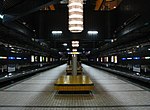MacEwan University

MacEwan University is a public undergraduate university located in the downtown core of Edmonton, Alberta, Canada. Formerly a two-year college, in 2009, it became Alberta's sixth university. MacEwan University offers ten baccalaureate degrees, one applied degree and 43 diploma and certificate programs. In addition, MacEwan University serves as the largest transfer-in post-secondary institution in Alberta. The university's four faculties and two schools offer programming in fine arts and communications, health and community studies, liberal arts and sciences, engineering, physical education, nursing, and business. The university also offers non-credit professional and personal development courses on a part-time basis, in addition to programming for university preparation and English-as-a-Second-Language courses. Its student body is more than 60% female, with more than 12,000 full-time students in credit programs and just over 19,000 students across all credit- and non-credit programs.
Excerpt from the Wikipedia article MacEwan University (License: CC BY-SA 3.0, Authors, Images).MacEwan University
Trans Canada Trail, Edmonton Central Core
Geographical coordinates (GPS) Address Nearby Places Show on map
Geographical coordinates (GPS)
| Latitude | Longitude |
|---|---|
| N 53.546944444444 ° | E -113.50472222222 ° |
Address
MacEwan University City Centre Campus
Trans Canada Trail
T5H 2Z4 Edmonton, Central Core
Alberta, Canada
Open on Google Maps




